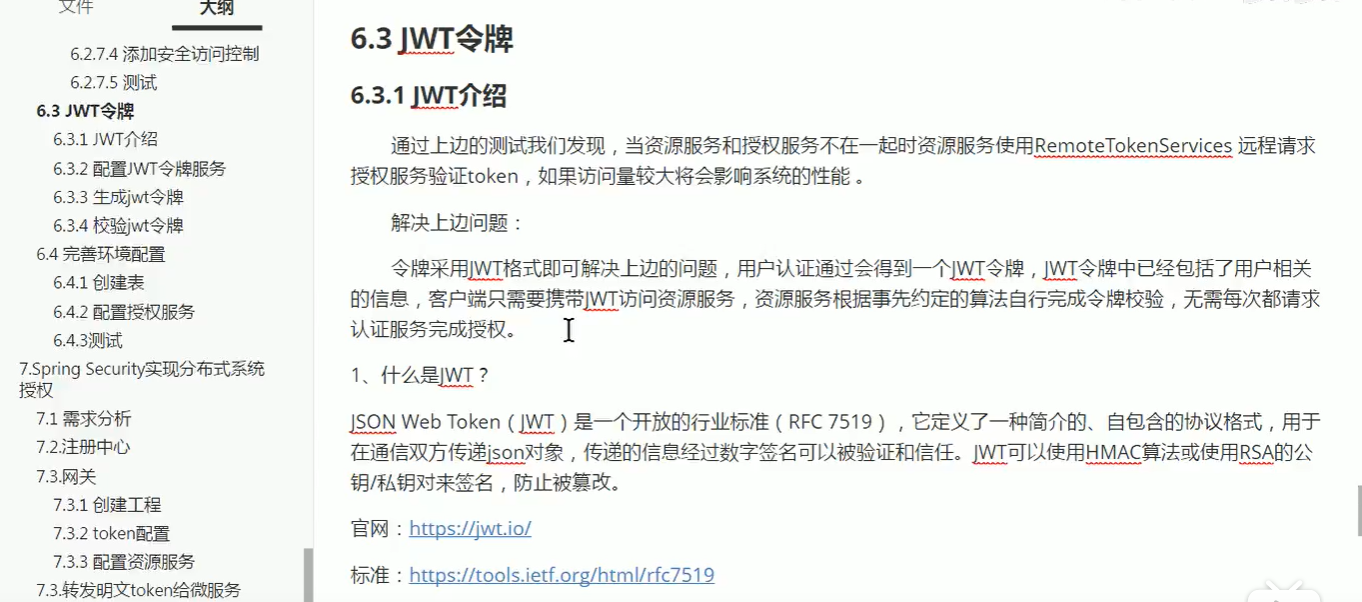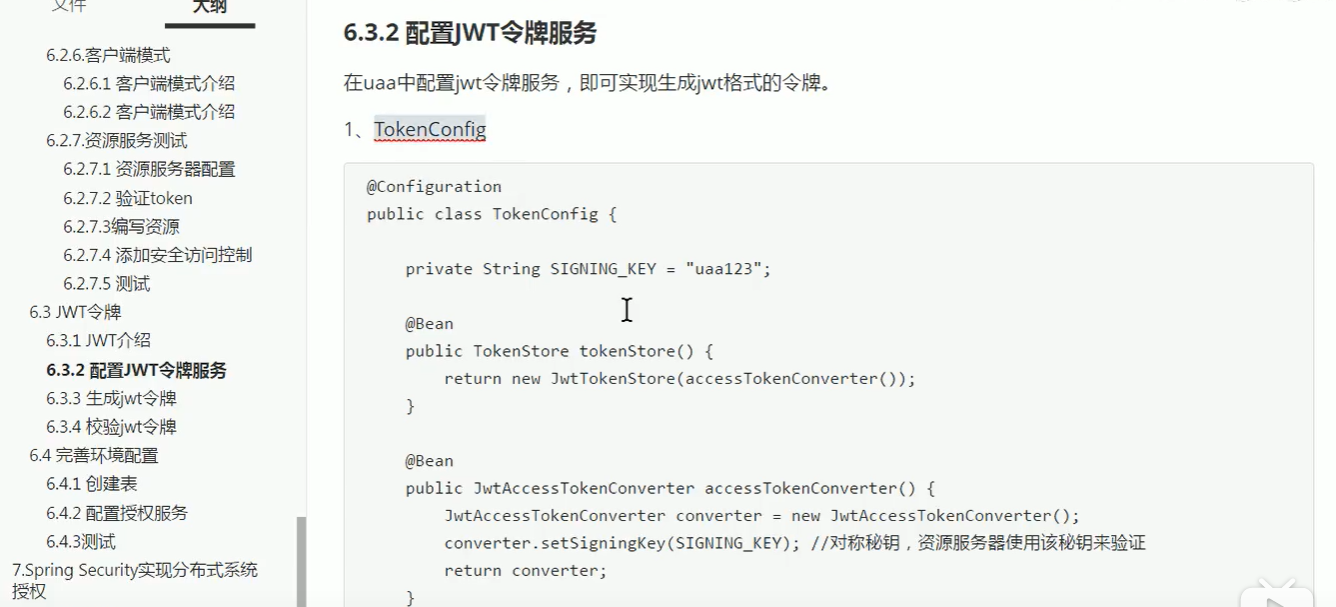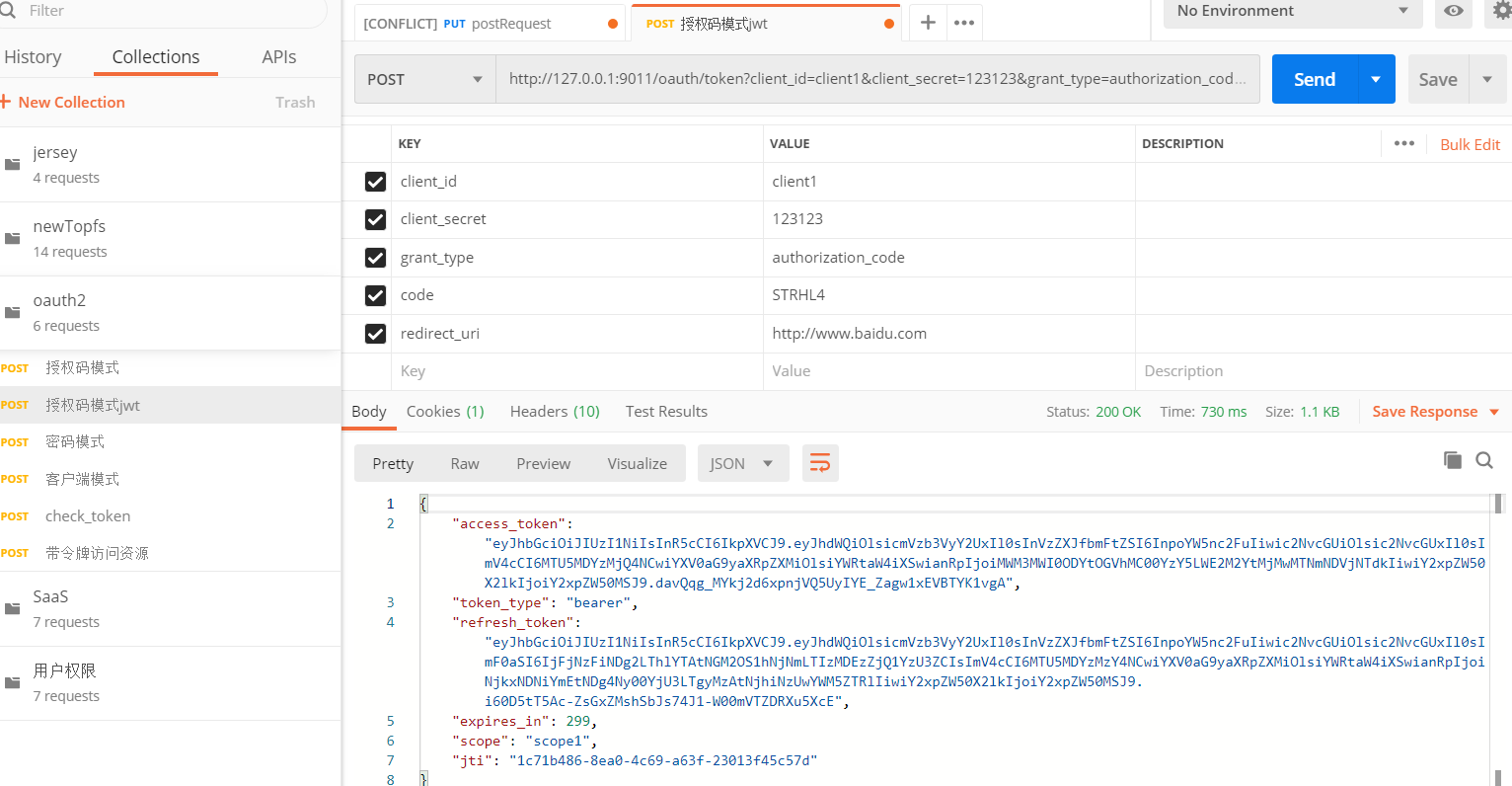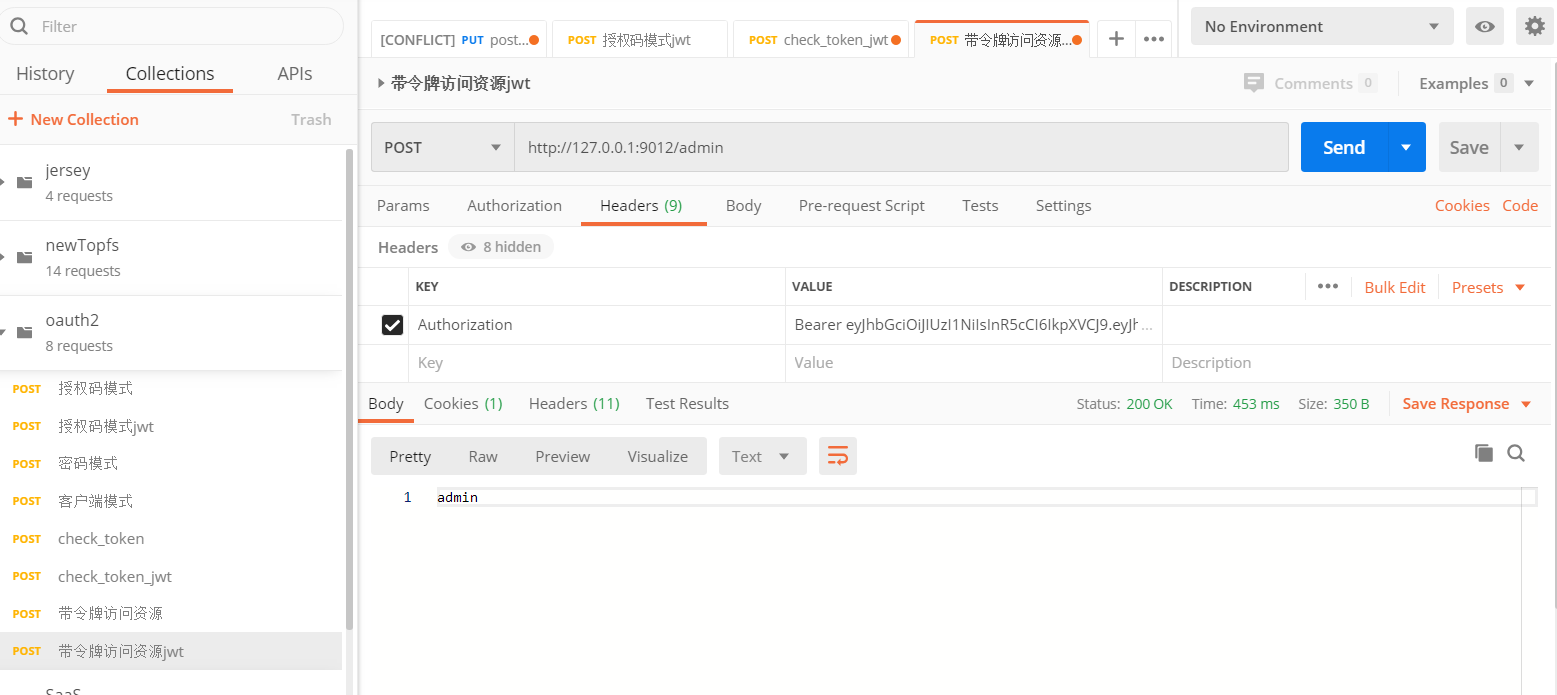OAuth2.0-2jwt令牌
JWT令牌
解决了之前普通令牌每次都要远程校验令牌带来得网络消耗;(有网友说可以将令牌验证从认证服务器上放到各个资源服务器上,不知是否可行?)

JWT令牌的优点:
1、jwt基于json,非常方便解析。
2、可以在令牌中自定义丰富的内容,易扩展。
3、通过非对称加密算法及数字签名技术,JWT防止篡改,安全性高。
4、资源服务使用JWT可不依赖认证服务即可完成授权。
缺点:
1、JWT令牌较长,占存储空间比较大。
1.1 令牌结构
通过学习JWT令牌结构为自定义jwt令牌打好基础。
JWT令牌由三部分组成,每部分中间使用点(.)分隔,比如:xxxxx.yyyyy.zzzzz
Header
头部包括令牌的类型(即JWT)及使用的哈希算法(如HMAC SHA256或RSA) 一个例子如下:
下边是Header部分的内容:
{ "alg": "HS256", "typ": "JWT" }
将上边的内容使用Base64Url编码,得到一个字符串就是JWT令牌的第一部分。
Payload
第二部分是负载,内容也是一个json对象,它是存放有效信息的地方,它可以存放jwt提供的现成字段,比如:iss(签发者),exp(过期时间戳), sub(面向的用户)等,也可自定义字段。
此部分不建议存放敏感信息,因为此部分可以解码还原原始内容。
最后将第二部分负载使用Base64Url编码,得到一个字符串就是JWT令牌的第二部分。
{ "sub": "1234567890", "name": "456", "admin": true }
Signature
第三部分是签名,此部分用于防止jwt内容被篡改。
这个部分使用base64url将前两部分进行编码,编码后使用点(.)连接组成字符串,最后使用header中声明签名算法进行签名。
一个例子:
HMACSHA256( base64UrlEncode(header) + "." +base64UrlEncode(payload),secret )
base64UrlEncode(header):jwt令牌的第一部分。
base64UrlEncode(payload):jwt令牌的第二部分。
secret:签名所使用的密钥。
有网友说:实际投产中,使用redis好一点,如果客户端过多,jwt就会很臃肿?


1.授权服务AuthorizationServerConfig
@Configuration //开启oauth2,auth server模式 @EnableAuthorizationServer public class AuthorizationServerConfig extends AuthorizationServerConfigurerAdapter { @Autowired private PasswordEncoder passwordEncoder; //配置客户端 @Override public void configure(ClientDetailsServiceConfigurer clients) throws Exception { clients.inMemory() //client的id和密码 .withClient("client1") .secret(passwordEncoder.encode("123123")) //给client一个id,这个在client的配置里要用的 .resourceIds("resource1") //允许的申请token的方式,测试用例在test项目里都有. //authorization_code授权码模式,这个是标准模式 //implicit简单模式,这个主要是给无后台的纯前端项目用的 //password密码模式,直接拿用户的账号密码授权,不安全 //client_credentials客户端模式,用clientid和密码授权,和用户无关的授权方式 //refresh_token使用有效的refresh_token去重新生成一个token,之前的会失效 .authorizedGrantTypes("authorization_code", "password", "client_credentials", "implicit", "refresh_token") //授权的范围,每个resource会设置自己的范围. .scopes("scope1", "scope2") //这个是设置要不要弹出确认授权页面的. .autoApprove(false) //这个相当于是client的域名,重定向给code的时候会跳转这个域名 .redirectUris("http://www.baidu.com"); } @Autowired private ClientDetailsService clientDetailsService; @Autowired private TokenStore tokenStore; @Autowired private JwtAccessTokenConverter tokenConverter; //配置token管理服务 @Bean public AuthorizationServerTokenServices tokenServices() { DefaultTokenServices defaultTokenServices = new DefaultTokenServices(); defaultTokenServices.setClientDetailsService(clientDetailsService); defaultTokenServices.setSupportRefreshToken(true); //配置token的存储方法 defaultTokenServices.setTokenStore(tokenStore); defaultTokenServices.setAccessTokenValiditySeconds(300); defaultTokenServices.setRefreshTokenValiditySeconds(1500); //配置token增强,把一般token转换为jwt token TokenEnhancerChain tokenEnhancerChain = new TokenEnhancerChain(); tokenEnhancerChain.setTokenEnhancers(Arrays.asList(tokenConverter)); defaultTokenServices.setTokenEnhancer(tokenEnhancerChain); return defaultTokenServices; } //密码模式才需要配置,认证管理器 @Autowired private AuthenticationManager authenticationManager; //把上面的各个组件组合在一起 @Override public void configure(AuthorizationServerEndpointsConfigurer endpoints) throws Exception { endpoints.authenticationManager(authenticationManager)//认证管理器 .authorizationCodeServices(new InMemoryAuthorizationCodeServices())//授权码管理 .tokenServices(tokenServices())//token管理 .allowedTokenEndpointRequestMethods(HttpMethod.POST); } //配置哪些接口可以被访问 @Override public void configure(AuthorizationServerSecurityConfigurer security) throws Exception { security.tokenKeyAccess("permitAll()")///oauth/token_key公开 .checkTokenAccess("permitAll()")///oauth/check_token公开 .allowFormAuthenticationForClients();//允许表单认证 } }
TokenConfig
@Configuration public class TokenConfig { //配置如何把普通token转换成jwt token @Bean public JwtAccessTokenConverter tokenConverter() { JwtAccessTokenConverter converter = new JwtAccessTokenConverter(); //使用对称秘钥加密token,resource那边会用这个秘钥校验token converter.setSigningKey("uaa123"); return converter; } //配置token的存储方法 @Bean public TokenStore tokenStore() { //把用户信息都存储在token当中,相当于存储在客户端,性能好很多 return new JwtTokenStore(tokenConverter()); } }
WebSecurityConfig
@Configuration @EnableGlobalMethodSecurity(securedEnabled = true, prePostEnabled = true) public class WebSecurityConfig extends WebSecurityConfigurerAdapter { @Bean public PasswordEncoder passwordEncoder() { return new BCryptPasswordEncoder(); } //密码模式才需要配置,认证管理器 @Bean @Override protected AuthenticationManager authenticationManager() throws Exception { return super.authenticationManager(); } @Override protected void configure(HttpSecurity http) throws Exception { http.csrf().disable() .authorizeRequests() .anyRequest().permitAll() .and() .formLogin() .and() .logout(); } @Override @Bean public UserDetailsService userDetailsService() { /** * 基于内存创建用户 */ InMemoryUserDetailsManager manager=new InMemoryUserDetailsManager(); manager.createUser(User.withUsername("zhangsan").password(passwordEncoder().encode("123")).authorities("admin").build()); manager.createUser(User.withUsername("lisi").password(passwordEncoder().encode("123")).authorities("user").build()); return manager; } }
2.资源服务ResourceServerConfig
@Configuration //开启oauth2,reousrce server模式 @EnableResourceServer public class ResourceServerConfig extends ResourceServerConfigurerAdapter { @Autowired private TokenStore tokenStore; @Override public void configure(ResourceServerSecurityConfigurer resources) throws Exception { resources //设置我这个resource的id, 这个在auth中配置, 这里必须照抄 .resourceId("resource1") .tokenStore(tokenStore)//原来是 .tokenServices(tokenServices())去调用远程验证,现在只需要自己验证自己即可 //这个貌似是配置要不要把token信息记录在session中 .stateless(true); } @Override public void configure(HttpSecurity http) throws Exception { http.csrf().disable() .authorizeRequests() //本项目所需要的授权范围,这个scope是写在auth服务的配置里的 .antMatchers("/**").access("#oauth2.hasScope('scope1')") .and() //这个貌似是配置要不要把token信息记录在session中 .sessionManagement().sessionCreationPolicy(SessionCreationPolicy.STATELESS); } }
TokenConfig
@Configuration public class TokenConfig { //配置如何把普通token转换成jwt token @Bean public JwtAccessTokenConverter tokenConverter() { JwtAccessTokenConverter converter = new JwtAccessTokenConverter(); //使用对称秘钥加密token,resource那边会用这个秘钥校验token converter.setSigningKey("uaa123");//密钥必须跟授权服务那边一样! return converter; } //配置token的存储方法 @Bean public TokenStore tokenStore() { //把用户信息都存储在token当中,相当于存储在客户端,性能好很多 return new JwtTokenStore(tokenConverter()); } }
WebSecurityConfig
@Configuration @EnableGlobalMethodSecurity(securedEnabled = true, prePostEnabled = true) public class WebSecurityConfig extends WebSecurityConfigurerAdapter { @Override protected void configure(HttpSecurity http) throws Exception { http.csrf().disable() .authorizeRequests() .anyRequest().permitAll(); } }
验证方式:参考上一章
//授权码模式
//浏览器访问
http://127.0.0.1:9011/oauth/authorize?client_id=client1&response_type=code&scope=scope1&redirect_uri=http://www.baidu.com

带令牌访问资源:

无需远程验证,直接令牌自己根据对称加解密 即可获取用户令牌内得权限信息





 浙公网安备 33010602011771号
浙公网安备 33010602011771号